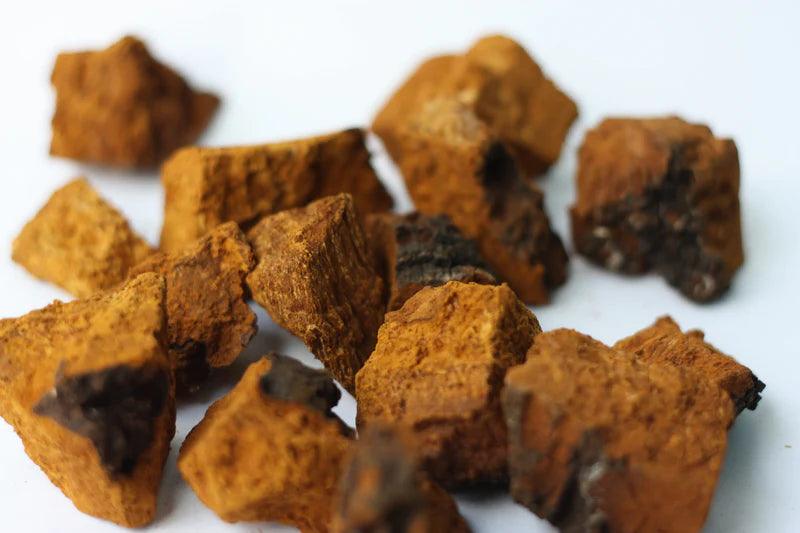
Chaga, taxonomically known as Inonotus obliquus, is a parasitic fungus found on various birch tree species. According to Jeff Chilton, coauthor of The Mushroom Cultivator: A Practical Guide to Growing Mushrooms at Home and founder, President, and CEO of Nammex Organic Mushroom Extracts, Chaga is neither a mushroom nor a sclerotia (i.e a mass of mycelium).
It’s a canker.
In essence, a canker is caused when the host tree pushes out a fungal infection within the tree, much like your body pushes out, say, a splinter.
Chasing Chaga
To identify Chaga in the wild, here are some general morphographic traits to look for:
A black, crusty, woody, tough bulb along a tree trunk that’s reminiscent in color and texture to charcoal
Red-orange coloration on the interior of the bulbous body
Found primarily on standing birch trees but can also be present on alder, beech and other hardwood trees
The stage of life that Chaga is in when it’s typically encountered is a sterile, asexual phase, meaning that a microscopic analysis of the spores to confirm identification is typically not possible.
A Cup of Chaga Tea Per Day...
Though human studies on Chaga’s medicinal benefits is scarce, animal and in vitro studies have demonstrated Chaga’s potential to reduce long-term inflammation and gut damage through the stimulation of white blood cells, promote the creation of beneficial proteins that regulate the immune system, — known as cytokines — and prevent/slow cancer cell growth in the liver, lungs, breast, prostate, and colon.
Other studies have shown Chaga may help reduce blood sugar levels and insulin resistance, reduce “bad” LDL cholesterol, total cholesterol, and triglycerides, and increase “good” HDL cholesterol.
Chaga is rich in triterpenoids — naturally occurring organic chemicals derived from the 5-carbon compound isoprene — and is one of the most antioxidant rich natural sources in the world, far surpassing the antioxidant content of blueberries, açai, and cacao.
Chaga possesses immunomodulating properties, fights free radicals, cleanses the liver, can help treat psoriasis, assist with digestive and gastric issues, regenerate organs and glands, provide pain relief, and ameliorate stomach ulcers. Finally, with a high zinc and melanin content, Chaga helps protect you from radiation.
Word of Caution
Chaga has been known to interact with some medications, especially for people on insulin or those with diabetes, given Chaga’s ability to impact blood sugar levels. Chaga also contains a protein that can prevent blood clotting. Lastly, Chaga may cause some people’s immune systems to become more active. As with any supplement, seek medical advice and consult with your doctor before beginning a Chaga supplementation.
Environmentally speaking, Chaga is a very slow-growing fungus and given its newfound popularity, prone to over harvesting. Therefore, consider the environmental impact of your Chaga consumption before deciding to give it a go. (Please note that all Troop products use sustainably harvested Chaga).
And if you ever come across a birch tree with a black, bulging, charcoal-like mass extruding from its trunk and are able to climb up and get a better look, keep an eye out for a red-orange interior and a nose out for the smell of earthy licorice. If it meets all three criteria, chances are you’ve found a Chaga mushroom! Now it’s up to you what to do with it.

